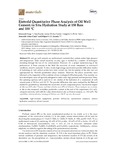Mostrar o rexistro simple do ítem
Rietveld Quantitative Phase Analysis of Oil Well Cement: in Situ Hydration Study at 150 Bars and 150 °C
| dc.contributor.author | Fraga, Edmundo | |
| dc.contributor.author | Cuesta, Ana | |
| dc.contributor.author | Zea-García, Jesus D. | |
| dc.contributor.author | Gómez de la Torre, María Ángeles | |
| dc.contributor.author | Yáñez, Armando | |
| dc.contributor.author | García Aranda, Miguel Ángel | |
| dc.date.accessioned | 2019-06-18T15:01:07Z | |
| dc.date.available | 2019-06-18T15:01:07Z | |
| dc.date.issued | 2019-12 | |
| dc.identifier.issn | 1996-1944 | |
| dc.identifier.uri | http://hdl.handle.net/2183/23247 | |
| dc.description.abstract | Abstract: Oil and gas well cements are multimineral materials that hydrate under high pressure and temperature. Their overall reactivity at early ages is studied by a number of techniques including through the use of the consistometer. However, for a proper understanding of then performance of these cements in the field, the reactivity of every component, in real‐world conditions, must be analysed. To date, in situ high energy synchrotron powder diffraction studies of hydrating oil well cement pastes have been carried out, but the quality of the data was not appropriated for Rietveld quantitative phase analyses. Therefore, the phase reactivities were followed by the inspection of the evolution of non‐overlapped diffraction peaks. Very recently, we have developed a new cell specially designed to rotate under high pressure and temperature. Here, this spinning capillary cell is used for in situ studies of the hydration of a commercial oil well cement paste at 150 bars and 150 °C. The powder diffraction data were analysed by the Rietveld method to quantitatively determine the reactivities of each component phase. The reaction degree of alite was 90% after 7 hours, and that of belite was 42% at 14 hours. These analyses are accurate, as the in situ measured crystalline portlandite content at the end of the experiment, 12.9 wt%, compares relatively well with the value determined ex situ by thermal analysis, i.e., 14.0 wt%. The crystalline calcium silicates forming at 150 bars and 150 °C are also discussed. | es_ES |
| dc.description.sponsorship | Ministerio de Economía y Competitividad; BIA2017‐82391‐R | |
| dc.language.iso | eng | es_ES |
| dc.rights | Atribución 4.0 España | es_ES |
| dc.rights.uri | http://creativecommons.org/licenses/by/4.0/es/ | * |
| dc.subject | Equilibrio líquido-vapor | es_ES |
| dc.subject | Rietveld, Método de | es_ES |
| dc.subject | Radiodifracción | es_ES |
| dc.subject | Radiación sincrotrón | es_ES |
| dc.subject | Reactividad (Química) | es_ES |
| dc.title | Rietveld Quantitative Phase Analysis of Oil Well Cement: in Situ Hydration Study at 150 Bars and 150 °C | es_ES |
| dc.type | info:eu-repo/semantics/article | es_ES |
| dc.rights.access | info:eu-repo/semantics/openAccess | es_ES |
| UDC.journalTitle | Materials | es_ES |
| UDC.volume | 12 | es_ES |
| UDC.issue | 12 | es_ES |
Ficheiros no ítem
Este ítem aparece na(s) seguinte(s) colección(s)
-
CIT-LAIL - Artigos [29]






